Salads: A Symphony of Freshness and Flavor
Salads, a term that signifies health, freshness, and a burst of flavors, is more than just a side dish. It's a culinary canvas that allows us to explore a myriad of ingredients, textures, and tastes. At Channelin' Granny, we understand that salads are not just about leafy greens, but also about the symphony of flavors that can be created with the right combination of ingredients.
Our salad recipes are inspired by traditional and modern culinary practices from around the world. We believe that every culture has its unique salad that reflects its lifestyle, dietary habits, and values. By exploring these diverse cuisines, we hope to bring you a taste of the world's salads, right in your own kitchen.
Channelin' Granny is your go-to resource for salad recipes that are fresh, flavorful, and healthy. We believe that every dish has a story to tell, and we're here to share these stories with you. Our recipes are a tribute to the timeless appeal of salads.
-
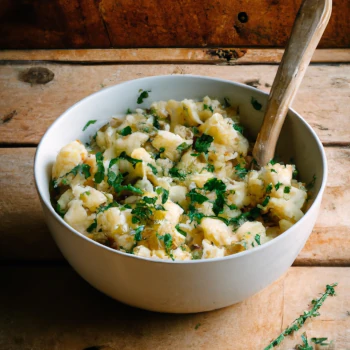
Granny's Homestyle Potato Salad
Dive into the comforting flavors of Granny's Homestyle Potato Salad, a harmonious mix of soft potatoes, crunchy celery, and a rich, creamy dressing.
-
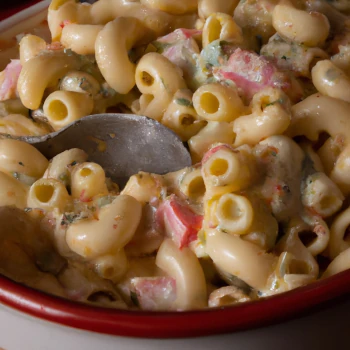
Granny's Creamy Macaroni Salad
Savor the delightful combination of soft macaroni, fresh veggies, and a luscious dressing in Granny's Creamy Macaroni Salad.
-
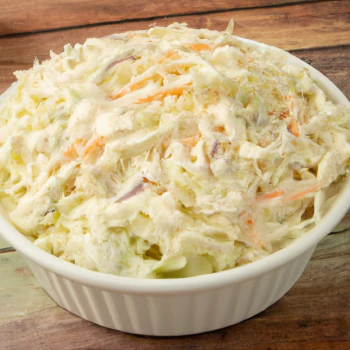
Granny's Classic Coleslaw
Relish the timeless charm of Granny's Classic Coleslaw, a symphony of fresh cabbage, carrot, onion, and a zesty dressing.
Salads Throughout the Centuries
Salad, a term derived from the Latin word "salata" meaning "salty", has a rich and varied history that spans cultures and centuries. The concept of salad has evolved significantly over time, from simple mixtures of greens with salt to complex creations featuring a variety of ingredients and dressings. The evolution of salad reflects the changing tastes and dietary habits of societies, as well as the influence of different cultures and cuisines.
The earliest recorded salads date back to ancient times. The Greeks and Romans enjoyed simple salads made from greens, vegetables, and herbs dressed with oil and vinegar. These salads were often served at the beginning of meals to stimulate the appetite. The Romans, in particular, were known for their love of raw vegetables, and their salads often included ingredients like cucumbers, onions, and radishes. These early salads were not just a part of daily meals, but also featured in religious rituals and feasts.
In the Middle Ages, salads were a common part of the European diet, but they were still quite simple, often consisting of greens with a dressing of oil, vinegar, and sometimes honey. It was during this time that the practice of serving salad before the main course became less common, with salads often being served at the end of the meal instead. This shift reflected the changing dining habits of the time, as well as the influence of the Church, which promoted the consumption of raw greens for their supposed health benefits.
The Renaissance period saw a greater variety of ingredients being used in salads, including fruits, nuts, and even flowers. Dressings became more complex as well, with the addition of ingredients like mustard and sugar. This period was marked by a fascination with exotic ingredients and elaborate presentations, and salads were no exception. They were often used as a canvas for showcasing the variety and abundance of the season's produce.
The 17th and 18th centuries saw the introduction of more elaborate salads, often featuring cooked vegetables, meats, and seafood. These salads were often served as main courses rather than as appetizers or side dishes. This was a time of exploration and colonization, and the exchange of foods and culinary ideas between the Old World and the New World greatly influenced the development of salads during this period.
The 19th and 20th centuries brought about a revolution in salad preparation and presentation, with the creation of salads like the Caesar salad, Cobb salad, and Waldorf salad. These salads featured a variety of ingredients and were often served as standalone meals. This period also saw the rise of the restaurant industry and the professional chef, which led to the creation of signature salads that are still popular today.
In the late 20th and early 21st centuries, salads have continued to evolve, with a focus on fresh, local ingredients and healthy eating. Salads today can feature a wide range of ingredients, from traditional greens and vegetables to grains, proteins, and a variety of dressings. The rise of global cuisine has also influenced salad-making, with ingredients and flavors from around the world being incorporated into salads.
The history of salad is a testament to the creativity and adaptability of cooks and chefs throughout the ages. From simple beginnings, salads have evolved into a culinary art form, with endless possibilities for flavor and presentation. Today, salads are more than just a side dish or an appetizer; they are a reflection of our diverse and global culinary landscape.
-
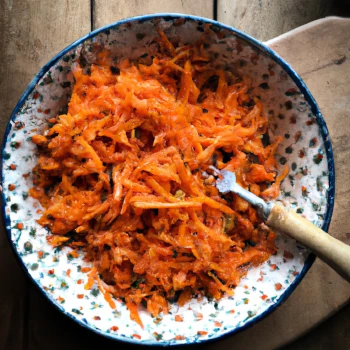
Granny's Homestyle Carrot Salad
Indulge in the vibrant flavors of Granny's Homestyle Carrot Salad, a medley of crisp carrots, aromatic herbs, and a tangy dressing.
-
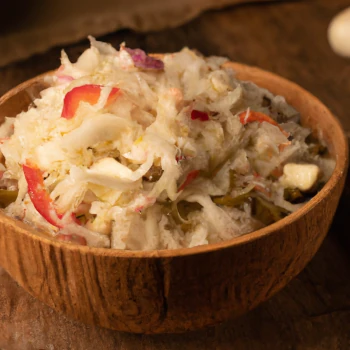
Granny's Tangy Sauerkraut Salad
Experience the unique tang of Granny's Tangy Sauerkraut Salad, a delightful mix of fermented cabbage, crisp vegetables, and a sweet and sour dressing.
-
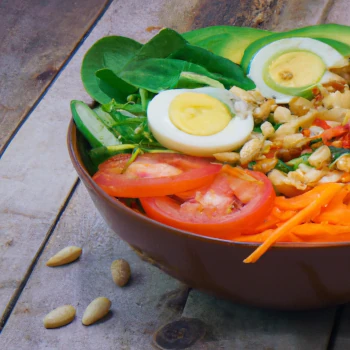
Granny's Green Garden Salad
Fresh and vibrant flavors define Granny's Green Garden Salad, a delightful blend of veggies. This salad is a testament to the power of simple, wholesome ingredients coming together to create something truly special.
Salad Around the World
Salads are a universal dish, enjoyed in various forms all around the globe. They reflect the unique culinary traditions and local produce of each region, resulting in a diverse array of flavors, textures, and ingredients. From the simple and fresh Mediterranean salads to the hearty and satisfying Russian salads, each region brings its own unique twist to this versatile dish. Let's embark on a culinary journey and explore the fascinating world of salads.
Salads of the Mediterranean often reflect the region's abundant fresh produce, with ripe tomatoes, crisp cucumbers, and tangy cheeses playing starring roles. These salads are typically dressed simply with olive oil and herbs, allowing the natural flavors of the ingredients to shine through.
French salads are known for their elegance and balance, often featuring a mix of cooked and raw ingredients. Fresh seafood, ripe tomatoes, and olives are common components, all dressed in high-quality olive oil.
Middle Eastern salads often feature fresh herbs, grains, and a burst of citrus. These salads are typically light and refreshing, often serving as a palate cleanser in a meal featuring a variety of dishes.
In Thailand, salads are known for their explosive flavors, with a balance of sweet, sour, salty, and spicy notes. Fresh fruits and vegetables are often used, along with a variety of proteins and a dressing that packs a punch.
Popular in many parts of the world, especially in North America and Northern Europe, creamy salads are a delightful variation that often feature a base of mayonnaise or sour cream. These salads can include a wide range of ingredients, such as potatoes, pasta, chicken, or various vegetables, all bound together by the rich, creamy dressing. The creaminess of the dressing provides a satisfying contrast to the crunch of the vegetables, resulting in a salad that is both hearty and refreshing. Whether served at a picnic, a potluck, or as a side dish for a family dinner, creamy salads are a comforting classic that never goes out of style.
Italian salads often showcase the country's famous cheeses and tomatoes, along with fresh basil. These salads are typically dressed simply with olive oil and salt, allowing the quality of the ingredients to take center stage.
Indian salads often provide a refreshing contrast to the country's rich and spicy dishes. These salads typically feature a mix of raw vegetables, with a squeeze of lime juice for acidity and a sprinkle of spices for added flavor.
In Russia and other post-Soviet countries, salads can be a hearty affair, featuring a mix of cooked vegetables, meats, and mayonnaise. These salads are often served as part of a larger meal, providing a comforting and satisfying component.
-

Cranberry Salad
Granny's Cranberry Salad is a sweet and tangy delight, perfect for a festive dinner at home. The vibrant and zesty flavors of this dish make it a perfect dessert to enjoy during the holiday season.
-
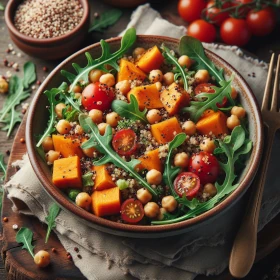
Chickpea Salad
Featuring a vibrant mix of creamy chickpeas, roasted sweet potatoes, fluffy quinoa, and a zesty dressing, each bite is a symphony of textures and flavors that will leave you wanting more. Nutritious and fulfilling.
Salad, a term derived from the Latin word "salata" meaning "salty", has a rich and varied history that spans cultures and centuries. The concept of salad has evolved significantly over time, from simple mixtures of greens with salt to complex creations featuring a variety of ingredients and dressings. The evolution of salad reflects the changing tastes and dietary habits of societies, as well as the influence of different cultures and cuisines.
The earliest recorded salads date back to ancient times. The Greeks and Romans enjoyed simple salads made from greens, vegetables, and herbs dressed with oil and vinegar. These salads were often served at the beginning of meals to stimulate the appetite. The Romans, in particular, were known for their love of raw vegetables, and their salads often included ingredients like cucumbers, onions, and radishes. These early salads were not just a part of daily meals, but also featured in religious rituals and feasts.
In the Middle Ages, salads were a common part of the European diet, but they were still quite simple, often consisting of greens with a dressing of oil, vinegar, and sometimes honey. It was during this time that the practice of serving salad before the main course became less common, with salads often being served at the end of the meal instead. This shift reflected the changing dining habits of the time, as well as the influence of the Church, which promoted the consumption of raw greens for their supposed health benefits.
The Renaissance period saw a greater variety of ingredients being used in salads, including fruits, nuts, and even flowers. Dressings became more complex as well, with the addition of ingredients like mustard and sugar. This period was marked by a fascination with exotic ingredients and elaborate presentations, and salads were no exception. They were often used as a canvas for showcasing the variety and abundance of the season's produce.
The 17th and 18th centuries saw the introduction of more elaborate salads, often featuring cooked vegetables, meats, and seafood. These salads were often served as main courses rather than as appetizers or side dishes. This was a time of exploration and colonization, and the exchange of foods and culinary ideas between the Old World and the New World greatly influenced the development of salads during this period.
The 19th and 20th centuries brought about a revolution in salad preparation and presentation, with the creation of salads like the Caesar salad, Cobb salad, and Waldorf salad. These salads featured a variety of ingredients and were often served as standalone meals. This period also saw the rise of the restaurant industry and the professional chef, which led to the creation of signature salads that are still popular today.
In the late 20th and early 21st centuries, salads have continued to evolve, with a focus on fresh, local ingredients and healthy eating. Salads today can feature a wide range of ingredients, from traditional greens and vegetables to grains, proteins, and a variety of dressings. The rise of global cuisine has also influenced salad-making, with ingredients and flavors from around the world being incorporated into salads.
The history of salad is a testament to the creativity and adaptability of cooks and chefs throughout the ages. From simple beginnings, salads have evolved into a culinary art form, with endless possibilities for flavor and presentation. Today, salads are more than just a side dish or an appetizer; they are a reflection of our diverse and global culinary landscape.
-

Granny's Homestyle Carrot Salad
Indulge in the vibrant flavors of Granny's Homestyle Carrot Salad, a medley of crisp carrots, aromatic herbs, and a tangy dressing.
-

Granny's Tangy Sauerkraut Salad
Experience the unique tang of Granny's Tangy Sauerkraut Salad, a delightful mix of fermented cabbage, crisp vegetables, and a sweet and sour dressing.
-

Granny's Green Garden Salad
Fresh and vibrant flavors define Granny's Green Garden Salad, a delightful blend of veggies. This salad is a testament to the power of simple, wholesome ingredients coming together to create something truly special.
Salad Around the World
Salads are a universal dish, enjoyed in various forms all around the globe. They reflect the unique culinary traditions and local produce of each region, resulting in a diverse array of flavors, textures, and ingredients. From the simple and fresh Mediterranean salads to the hearty and satisfying Russian salads, each region brings its own unique twist to this versatile dish. Let's embark on a culinary journey and explore the fascinating world of salads.
Salads of the Mediterranean often reflect the region's abundant fresh produce, with ripe tomatoes, crisp cucumbers, and tangy cheeses playing starring roles. These salads are typically dressed simply with olive oil and herbs, allowing the natural flavors of the ingredients to shine through.
French salads are known for their elegance and balance, often featuring a mix of cooked and raw ingredients. Fresh seafood, ripe tomatoes, and olives are common components, all dressed in high-quality olive oil.
Middle Eastern salads often feature fresh herbs, grains, and a burst of citrus. These salads are typically light and refreshing, often serving as a palate cleanser in a meal featuring a variety of dishes.
In Thailand, salads are known for their explosive flavors, with a balance of sweet, sour, salty, and spicy notes. Fresh fruits and vegetables are often used, along with a variety of proteins and a dressing that packs a punch.
Popular in many parts of the world, especially in North America and Northern Europe, creamy salads are a delightful variation that often feature a base of mayonnaise or sour cream. These salads can include a wide range of ingredients, such as potatoes, pasta, chicken, or various vegetables, all bound together by the rich, creamy dressing. The creaminess of the dressing provides a satisfying contrast to the crunch of the vegetables, resulting in a salad that is both hearty and refreshing. Whether served at a picnic, a potluck, or as a side dish for a family dinner, creamy salads are a comforting classic that never goes out of style.
Italian salads often showcase the country's famous cheeses and tomatoes, along with fresh basil. These salads are typically dressed simply with olive oil and salt, allowing the quality of the ingredients to take center stage.
Indian salads often provide a refreshing contrast to the country's rich and spicy dishes. These salads typically feature a mix of raw vegetables, with a squeeze of lime juice for acidity and a sprinkle of spices for added flavor.
In Russia and other post-Soviet countries, salads can be a hearty affair, featuring a mix of cooked vegetables, meats, and mayonnaise. These salads are often served as part of a larger meal, providing a comforting and satisfying component.
-

Cranberry Salad
Granny's Cranberry Salad is a sweet and tangy delight, perfect for a festive dinner at home. The vibrant and zesty flavors of this dish make it a perfect dessert to enjoy during the holiday season.
-

Chickpea Salad
Featuring a vibrant mix of creamy chickpeas, roasted sweet potatoes, fluffy quinoa, and a zesty dressing, each bite is a symphony of textures and flavors that will leave you wanting more. Nutritious and fulfilling.
Salads are a universal dish, enjoyed in various forms all around the globe. They reflect the unique culinary traditions and local produce of each region, resulting in a diverse array of flavors, textures, and ingredients. From the simple and fresh Mediterranean salads to the hearty and satisfying Russian salads, each region brings its own unique twist to this versatile dish. Let's embark on a culinary journey and explore the fascinating world of salads.
Salads of the Mediterranean often reflect the region's abundant fresh produce, with ripe tomatoes, crisp cucumbers, and tangy cheeses playing starring roles. These salads are typically dressed simply with olive oil and herbs, allowing the natural flavors of the ingredients to shine through.
French salads are known for their elegance and balance, often featuring a mix of cooked and raw ingredients. Fresh seafood, ripe tomatoes, and olives are common components, all dressed in high-quality olive oil.
Middle Eastern salads often feature fresh herbs, grains, and a burst of citrus. These salads are typically light and refreshing, often serving as a palate cleanser in a meal featuring a variety of dishes.
In Thailand, salads are known for their explosive flavors, with a balance of sweet, sour, salty, and spicy notes. Fresh fruits and vegetables are often used, along with a variety of proteins and a dressing that packs a punch.
Popular in many parts of the world, especially in North America and Northern Europe, creamy salads are a delightful variation that often feature a base of mayonnaise or sour cream. These salads can include a wide range of ingredients, such as potatoes, pasta, chicken, or various vegetables, all bound together by the rich, creamy dressing. The creaminess of the dressing provides a satisfying contrast to the crunch of the vegetables, resulting in a salad that is both hearty and refreshing. Whether served at a picnic, a potluck, or as a side dish for a family dinner, creamy salads are a comforting classic that never goes out of style.
Italian salads often showcase the country's famous cheeses and tomatoes, along with fresh basil. These salads are typically dressed simply with olive oil and salt, allowing the quality of the ingredients to take center stage.
Indian salads often provide a refreshing contrast to the country's rich and spicy dishes. These salads typically feature a mix of raw vegetables, with a squeeze of lime juice for acidity and a sprinkle of spices for added flavor.
In Russia and other post-Soviet countries, salads can be a hearty affair, featuring a mix of cooked vegetables, meats, and mayonnaise. These salads are often served as part of a larger meal, providing a comforting and satisfying component.
-

Cranberry Salad
Granny's Cranberry Salad is a sweet and tangy delight, perfect for a festive dinner at home. The vibrant and zesty flavors of this dish make it a perfect dessert to enjoy during the holiday season.
-

Chickpea Salad
Featuring a vibrant mix of creamy chickpeas, roasted sweet potatoes, fluffy quinoa, and a zesty dressing, each bite is a symphony of textures and flavors that will leave you wanting more. Nutritious and fulfilling.